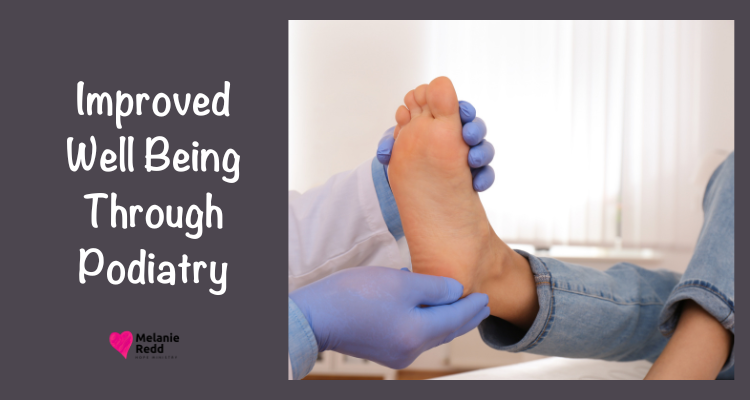Improved Well Being Through Podiatry

Improved Well-Being Through Podiatry
Podiatry plays a vital role in mobility and well-being by keeping feet, ankles, and lower legs healthy. This little-understood medical specialty prevents diagnoses, and treats conditions affecting these foundational structures.
Led by podiatrists, and specialized physicians with extensive training, podiatry focuses on customized patient education. In addition, it focuses on treatments and care coordination to maintain active lifestyles.
This article explores how podiatrists’ expertise in all aspects of foot health helps people of all ages avoid pain and impairment.
The Origins of Podiatry
Modern podiatry traces back to the late 18th century when the very first textbooks focused on foot care and shoe construction. These were published in Europe, bringing academic attention to disorders causing disability.
However, it was not until the late 19th century that the term “Chiropodist” (meaning treatment of the foot) was coined. This led to the gradual establishment of training courses in Europe and North America. These courses teach anatomy, orthopedics, and therapeutic foot techniques.
Over the early 20th century, advancing disciplines widened the scope of lower limb pathology necessitating a transition to the more formal designation of podiatry practitioners as physicians.
Today’s doctors of podiatric medicine undergo medical training equivalent to other specialists.
Training and Education – Improved Well-Being Through Podiatry
The training required to become a podiatrist begins with obtaining a Bachelor’s degree centered on the scientific building blocks of medicine. These include coursework in biology, anatomy, physiology, pathology, physics, and chemistry.
This base education is followed by four years at a specialized podiatric medical school, leading to a Doctor of Podiatric Medicine (DPM) degree.
Rigorous residency programs then provide aspiring podiatrists with 3-4 years of supervised clinical experience. Students work across hospital departments like surgery, wound care, internal medicine, radiology, and physical therapy.
Optional fellowship training of 1-2 years enables podiatrists to subspecialize further and gain expertise in disciplines like sports medicine, pediatrics, or diabetic foot care. Board certification demonstrates mastery in areas of specialization – especially vital for podiatric surgeons.
According to a respected podiatrist with over 20 years of experience – Dr. David Farnen – preventing minor foot problems from progressing into major complications later on lies at the essence of maintaining wellness.
By providing consistent foot health education and care from childhood into adulthood, podiatrists enable people to remain pain-free and active throughout their lives. Children’s Podiatry Melbourne plays a crucial role in this journey, offering specialized treatments and preventive care to support proper foot development from an early age.
Importance of Foot Health
Feet provides the critical foundation supporting people’s bodies across a lifetime, making their health integral to mobility and wellbeing.
However, as a commonly overlooked area, even minor foot issues often progress into severely debilitating conditions over time when left unaddressed.
Seemingly normal variations in infants like flat feet or high arches lead to painful bunions, hammertoes, and arthritis later on without proper early intervention.
Pressure from shoes creates corns, calluses, and ingrown toenails prone to infection.
Sudden injuries can trigger chronic cartilage breakdown, arthritis flares, and flexibility loss without prompt treatment.
Diabetes coupled with smoking constricts blood vessels, depriving tissue of oxygen and nutrients, allowing wounds to spiral into gangrene. Podiatrists possess advanced expertise to provide tailored care enabling patients to remain mobile. Moreover, they do this by halting the progression of foot problems before they impair comfort and quality of life long-term.
Role of Podiatrists – Improved Well-Being Through Podiatry
As medical specialists devoted to lower limb health, podiatrists have a multifaceted role centered on keeping feet pain-free and functional.
A major focus is patient education on prevention – customized hygiene protocols, selecting appropriate footwear to avoid pressure points, orthotic inserts to maintain structural alignment, and providing support to abnormal arches or foot types are all vital preventative measures, especially for high-risk groups like diabetics.
Annual foot health assessments enable early diagnosis and prompt care before issues escalate or spread.
During appointments, podiatrists conduct thorough examinations checking for swelling, skin breaks, changes in temperature/color, and pain levels while moving the foot and toes in all directions to gauge the range of motion.
Even more, tools like pin prick tests help assess nerve damage especially important for those with diabetes.
Custom orthotics may be prescribed to redistribute weight away from problem areas. Also, these orthotics can support abnormal foot architecture exacerbated by ligament laxity and repetitive injury.
Foot Surgeries
Surgeries range from minimally invasive procedures like correcting hammertoes and bunions to total joint replacements and fusions for end-stage arthritic feet.
High-risk patients also undergo vascular assessments periodically.
When needed, podiatrists coordinate additional care with specialists like endocrinologists, vascular surgeons, and wound care experts for optimal treatment of complex cases.
Enhancing Wellbeing – Improved Well-Being Through Podiatry
By expertly treating conditions affecting mobility and comfort, podiatric care alleviates pain by keeping people active. Additionally, they can encourage people to be healthy and engaged in fulfilling lives.
Also, consistent foot health maintenance enables athletes to perform at their peak, while preventing career-ending injuries.
Those suffering from chronic diseases like diabetes and arthritis achieve tighter control over their illness and halt the progression of complications through vigilant foot monitoring and prompt intervention.
For senior adults and high fall-risk groups, immediate care for strains and fractures by podiatrists restores independence and reduces the risk of repeat injuries. Patients battling obesity, vascular insufficiency, and chronic infections require an interdisciplinary collaborative care plan initiated by the podiatrist to save limbs and lives.
Podiatry Care Enhances Life Care
Across populations, preserving lower limb wellness through regular podiatry care enhances physical abilities and emotional health – thereby maximizing longevity and quality of life. Utilizing a specialized health and wellness platform, such as Noterro, can significantly improve the management of lower limb health.
By offering streamlined solutions tailored for wellness practitioners, Noterro empowers healthcare providers. They can seamlessly manage patient records, schedule appointments, and personalize care plans. This ensures patients receive consistent, high-quality care that supports their mobility and overall well-being.
Even more, integrating digital tools like these can greatly aid practitioners in delivering comprehensive podiatry services that align with patients’ health goals, ultimately promoting sustained wellness and longevity.
Common Foot Conditions
Several common podiatric issues stem from inherited anomalies, cumulative microtrauma, and nerve damage. Bunions often result from genetics causing a gradual deviation of the big toe over years exacerbated by wearing narrow-toed shoes rubbing against bone protrusions.
Indeed, the constant friction causes inflammation and intense arthritis-like pain. Initial bunion treatments focus on relieving pressure with toe spacers and pads. Custom orthotics help slow progression, but surgery to realign the joint becomes necessary for advanced stages.
In addition, ingrown toenails arise when the sharp edges of the nail grow into the skin and fold alongside it instead of straight outward. Repeated pressure and injury during walking cause redness, swelling, and eventually infection and crusty discharge if left untreated. Podiatrists remove problematic nail portions and permanently destroy the cuticle to prevent recurrence.
Also, neuromas or thickened inflamed nerve tissue develop between toes overloaded by repetitive injury and compression forces. Metatarsal padding helps early on but cortisone injections or surgical removal become necessary as inflammation spreads causing numbness in the toes.
Peripheral neuropathy from diabetes mellitus and other systemic diseases causes tingling and eventual numbness in feet due to depriving nerves of blood supply. Vigilant foot care is vital to prevent and halt progression.
Prevention Is Key
While podiatrists treat established conditions, a central tenet guiding practice is prevention. Much foot-related suffering and disability can be avoided from childhood through the decades by following basic foot health principles.
Annual routine podiatry check-ups provide opportunities for screening and early diagnosis so problems can be addressed promptly before advancing to complex stages.
In essence, Doctor Farnen ensures all patients understand ideal foot hygiene protocols, the selection of appropriate shoe gear with adequate support and toe room, use of orthotics to maintain structural alignment in the context of their unique needs.
High-risk groups including diabetics also learn how to check their feet daily and seek help quickly for cuts not healing. These basic self-care habits reinforced consistently during regular maintenance visits are key for restoring optimal health.
To Summarize
Truly, the extensive training and expertise of podiatrists fulfill a vital role in healthcare.
As highly specialized physicians devoted to keeping feet free of pain or impairment, they enhance comfort. Also, they increase mobility, and quality of life through every phase of life. They do this all while preventing minor problems from progressing into complex issues impacting overall health.
By coordinating care plans and working alongside other medical and surgical specialists when appropriate, they help restore well-being and maximize patient potential.
Were you encouraged by what you read?
Then, would you share this article with a friend, co-worker, or family member?
Or, maybe you can send it to a friend or family member?
This blog occasionally uses affiliate links and may contain affiliate links. Additionally, Melanie Redd is a participant in the Amazon Services LLC Associates Program.
This is an affiliate advertising program designed to provide a means for sites to earn advertising fees. These are earned by advertising and linking to amazon.com. Also, for more on my disclosure policy, click HERE.
© Melanie Redd and Hope Ministry, 2024. Unauthorized use and/or duplication of this material without express and written permission from this blog’s author and/or owner is strictly prohibited.
Further, excerpts and links may be used, provided that full and clear credit is given to Melanie Redd and Hope Ministry, LLC. Please give appropriate and specific directions to the original content.



0 Comments